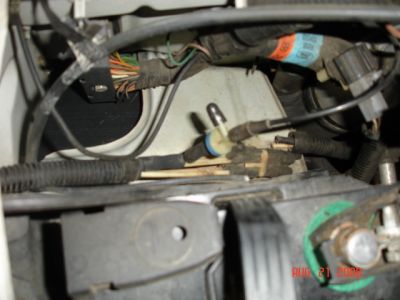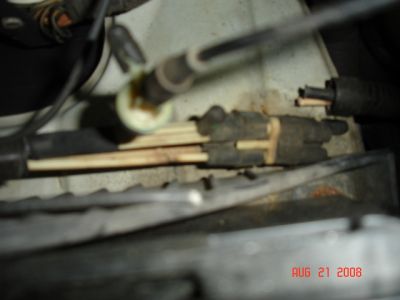There is an issue with MAF sensors(at air filter box) Heres the TSB, read and learn!
ARTICLE BEGINNING MASS AIR FLOW (MAF) - SENSOR CONTAMINATION - SERVICE TIP APPLICATION 1994-99 Econoline, F-150. F-250 LD,
ISSUE This TSB article is a diagnostic procedure to address vehicles that exhibit lean driveability symptoms and may or may not have any Diagnostic Trouble Codes (DTCs) stored in memory. ACTION Follow the diagnostic procedures described in the following SERVICE TIP . The revised diagnostic procedure is a more accurate means of diagnosing the symptoms. SERVICE TIP MASS AIR FLOW (MAF) DISCUSSION MAF sensors can get contaminated from a variety of sources: dirt, oil, silicon, spider webs, potting compound from the sensor itself, etc. When a MAF sensor gets contaminated, it skews the transfer function such that the sensor over-estimates air flow at idle (causes the fuel system to go rich) and under-estimates air flow at high air flows (causes fuel system to go lean). This means Long Term Fuel Trims will learn lean (negative) corrections at idle and learn rich (positive) corrections at higher air flows. If vehicle is driven at Wide Open Throttle (WOT) or high loads, the fuel system normally goes open loop rich to provide maximum power. If the MAF sensor is contaminated, the fuel system will actually be lean because of under-estimated air flow. During open loop fuel operation, the vehicle applies Long Term Fuel Trim corrections that have been learned during closed loop operation. These corrections are often lean corrections learned at lower air flows. This combination of under-estimated air flow and lean fuel trim corrections can result in spark knock/detonation and lack of power concerns at WOT and high loads.
One of the indicators for diagnosing this condition is barometric pressure. Barometric pressure (BARO) is inferred by the Powertrain Control Module (PCM) software at part throttle and WOT (there is no actual BARO sensor on MAF-equipped vehicles, except for the 3.8L Supercharged engine). At high air flows, a contaminated MAF sensor will under-estimate air flow coming into the engine, hence the PCM infers that the vehicle is operating at a higher altitude. The BARO reading is stored in Keep Alive Memory (KAM) after it is updated. Other indicators are Long Term Fuel Trim and MAF voltage at idle. Symptoms à   Lack of Power à   Spark Knock/Detonation à   Buck/Jerk à   Hesitation/Surge on Acceleration à   Malfunction Indicator Lamp (MIL) Illuminated DTCs P0171, P0172, P0174, P0175 may be stored in memory OBDII DTCs à   P0171, P0174 (Fuel system lean, Bank 1 or 2) à   P0172, P0175 (Fuel system rich, Bank 1 or 2) à   P1130, P1131, P1132, (HO2S11 lack of switching, Bank 1) à   P1150, P1151, P1152, (HO2S21 lack of switching, Bank 2) OBDI DTCs à   181, 189 (Fuel system lean, Bank 1 or 2) à   179, 188 (Fuel system rich, Bank 1 or 2) à   171, 172, 173 (HO2S11 lack of switching, Bank 1) à   175, 176, 177 (HO2S21 lack of switching, Bank 2) à   184, 185 (MAF higher/lower than expected) à   186, 187 (Injector pulse width higher/lower than expected) 1. Look at the BARO PID. Refer to the BAROMETRIC PRESSURE REFERENCE TABLE in this article. At sea level, BARO should read about 159 Hz (29.91 in. Hg). As NOTE: The following procedure may also be used to diagnose vehicles that do not have fuel system/HO2S sensor DTCs. NOTE: Do not disconnect the battery. It will erase Keep Alive Memory and reset Long Term Fuel Trim and BARO to their starting/base values. The BARO Parameter Identification Display (PID) is used for this diagnostic procedure. All OBDII applications have this PID available. There are some OBDI vehicles that do not have the BARO PID, for these vehicles omit the BARO check and refer only to steps 2, 3, and 4 in the diagnostic procedure.
a reference, Denver, Colorado at 1524 meters (5000 ft.) altitude should be about 144 Hz (24.88 in. Hg.). Normal learned BARO variability is up to +/-6 Hz (+/-2 in. Hg.). If BARO indicates a higher altitude than you are at (7 or more Hz lower than expected), you may have MAF contamination. If available, Service Bay Diagnostic System (SBDS) has a Manifold Absolute Pressure (MAP) sensor that can be used as a barometric pressure reference. Use "MAP/BARO" test under "Powertrain," "Testers and Meters." Ignore the hookup screen. Connect GP2 to the reference MAP on the following screen.
NOTE: Remember that most weather services report a local barometric pressure that has been corrected to sea level. the BARO PID, on the other hand, reports the actual barometric pressure for the altitude the vehicle is being operated in. Local weather conditions (high and low pressure areas) will change the local barometric pressure by several inches of mercury (+/-3 Hz, +/-1 in. Hg.). NOTE: BARO is updated only when the vehicle is at high throttle openings. Therefore, a vehicle which is driven down from a higher altitude may not have had an opportunity to update the BARO value in KAM. If you are not confident that BARO has been updated, perform three or four heavy, sustained accelerations at greater than half-throttle to allow BARO to update.

https://www.2carpros.com/forum/automotive_pictures/62217_150_1.jpg" alt="
https://www.2carpros.com/forum/automotive_pictures/62217_150_1.jpg" />
(LONGFT1 and/or LONGFT2 PIDs). If it is more negative than -12%, the fuel system has learned lean corrections which may be due to the MAF sensor over-estimating air flow at idle. Note that both Banks 1 and 2 will exhibit negative corrections for 2-bank system. If only one bank of a 2-bank system has negative corrections, the MAF sensor is probably not contaminated. 3. On a fully warmed up engine, look at MAF voltage at idle, in Neutral, A/C off (MAF V PID). If it's 30% greater than the nominal MAF V voltage listed in the Powertrain Control/Emissions Diagnosis (PC/ED) Diagnostic Value Reference Charts for your vehicle, or greater than 1.1 volts as a rough guide, the MAF sensor is over-estimating air flow at idle. 4. If at least two of the previous three steps are true, proceed to disconnect the MAF sensor connector. This puts the vehicle into Failure Mode and Effects Management (FMEM). In FMEM mode, air flow is inferred by using rpm and throttle position instead of reading the MAF sensor. (In addition, the BARO value is reset to a base/unlearned value.) If the lean driveability symptoms go away, the MAF sensor is probably contaminated and should be replaced. If the lean driveability symptoms do not go away, go to the PC/ED Service Manual for the appropriate diagnostics. After replacing the MAF sensor, disconnect the vehicle battery (5 minutes, minimum) to reset KAM, or on newer vehicles, use the "KAM Reset" feature on the New Generation Star (NGS) Tester and verify that the lean driveability symptoms are gone. WARRANTY INFORMATION WARRANTY STATUS: Information Only. OASIS CODES: 206000, 610000, 610500, 610600, 610700, 611000, 611500, 612000, 612500, 614000, 614500, 614600, 698298 NOTE: Due to increasingly stringent emission/OBDII requirements, it is possible for some vehicles with MAF sensor contamination to set fuel system DTCs and illuminate the MIL with no driveability concerns. Disconnecting the MAF on these vehicles will, therefore, produce no improvements in driveability. In these cases, if the BARO, LONGFT1, LONGFT2, and MAF V PIDs indicate that the maf is contaminated, proceed to replace the MAF sensor.
3/2/2009
Sunday, February 3rd, 2019 AT 12:31 PM
(Merged)





